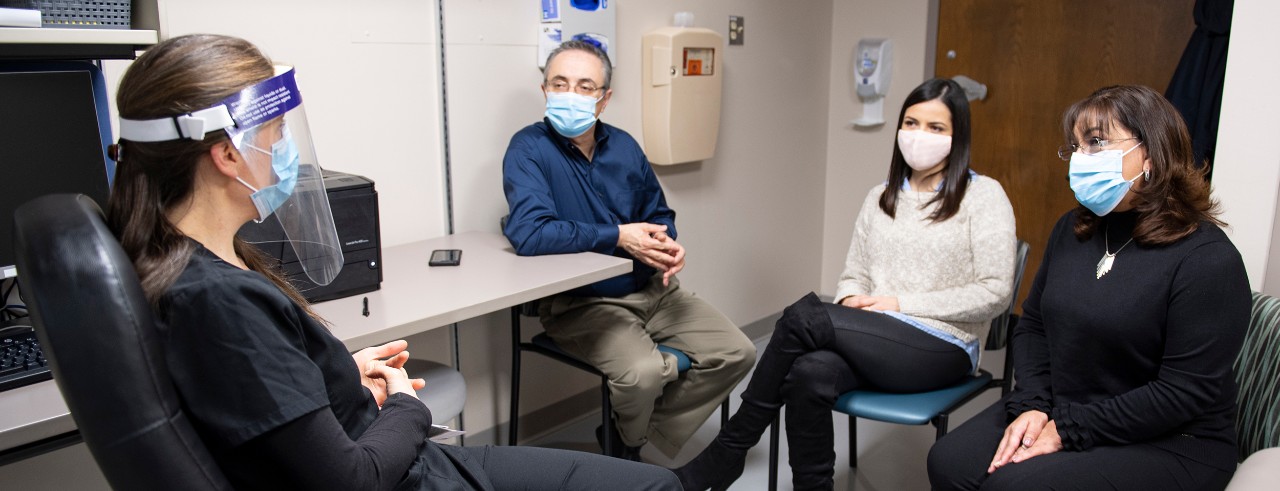
UC research examines barriers to treatment of COVID-19 in local Latinx families
Study suggests interventions should be centered on community partnerships and trusted messengers
Research from the University of Cincinnati examines the barriers as well as those that are helpful in the prevention and treatment of COVID-19 in Latinx families in Cincinnati.
The study, in collaboration with Cincinnati Children’s Hospital Medical Center, is funded by the Center for Clinical & Translational Science & Training.
Researchers identified primary barriers that include insecurities in food, jobs and housing and immigration. Key facilitators included having trusted messengers of health-related information.
The research was published in the Journal of Racial and Ethnic Health Disparities.
Latinx adults 18 years of age and older completed 255 quantitative surveys and 17 qualitative surveys during the summer of 2020.
“We went to a couple of different agencies and locations where the community already goes and feels safe,” says Shaina Horner, clinical research coordinator in the Division of Infectious Diseases in the Department of Internal Medicine at the UC College of Medicine and community research partner for the study.
Those locations included Cincinnati-area nonprofits Su Casa Hispanic Center and Santa Maria Community Services, both of which help Latinx families with educational, financial and health goals. Researchers also visited an apartment complex in a Cincinnati suburb, as well as a mobile home park in Northern Kentucky with a significant Latinx population.
“We started with paper surveys that we filled out for participants using their answers because of language barriers. Literacy levels can be a barrier when we are gathering information,” says Horner, who speaks fluent Spanish. “If you have a first- or second-grade education, a big piece of paper with a ton of questions can feel a little overwhelming and sometimes the information itself can feel overwhelming.
“If I'm having a conversation with someone, and they don't understand the question, we can talk about it whereas if they see it on the paper and they don't understand they might not ask,” said Horner.
After completing the quantitative surveys, Horner completed 17 qualitative interviews with interested participants for a deeper understanding of their experiences and concerns. These surveys and interviews were then coded, so the researchers could note themes.

Shaina Horner takes the blood pressure of Cristina Morgan/Photo/Colleen Kelley/UC Marketing + Brand
What Horner and the research team started to see from the surveys and conversations was people were experiencing food instability and housing instability. There was a large fear of losing jobs. For those who were undocumented there was the added fear of asking for masks or gloves in the workplace thinking it might put themselves at risk.
“We didn't go in trying to do any kind of health education, we were really just there to understand people's perspectives. It was really nice on that level because we got a lot of information that maybe people wouldn't have said if they felt like we were trying to convince them of something,” Horner says.
“We were also trying to learn where they got their COVID-19 information from, because there's a lot of information and misinformation out there about COVID. The sources of information people use are really important.”
The study found that people were getting information from a wide variety of sources, including social media, friends and family, church leaders and news outlets, especially Spanish radio. Some were getting information from health care providers, but that frequently came from pediatricians when taking their children to appointments, not because they were checking directly for themselves.
We need to find out why some people have difficulty having access to care. Let's try to eliminate some of those barriers.
Shaina Horner
“I think it's important to continue to educate the community,” Horner says. “UC and UC Health have done some of that work with the videos we've done around COVID. Once the Moderna vaccine was approved, we started to get information out there about what to expect when getting the vaccine or the difference between a vaccine reaction versus illness symptoms.”
Horner describes these issues as a public health concern.
“How do we intervene in communities where we see these disparities in ways that are actually going to impact the health of those communities?” she says.
Horner believes interventions require collaboration and should be community led. “We need to find out why some people have difficulty having access to care. Let's try to eliminate some of those barriers. Sometimes that means bringing the mobile health unit to their community because of transportation issues. Sometimes it means something in our system needs to change because people are afraid to seek care or don't come because of systemic barriers.”
The COVID-19 pandemic has presented health care systems with an opportunity to recognize these public health disparities and to make changes now that will improve access to care and education for at-risk populations in future public health emergencies, Horner says.
Lead photo of Shaina Horner, left, with Jose Octavio Aleman Ruiz, his daughter Cristina Morgan, and his wife, Cristina Solis Mendiola/Colleen Kelley/UC Marketing + Brand
Next Lives Here
The University of Cincinnati is classified as a Research 1 institution by the Carnegie Commission and is ranked in the National Science Foundation's Top-35 public research universities. UC's medical, graduate and undergraduate students and faculty investigate problems and innovate solutions with real-world impact. Next Lives Here.
Related Stories
Challenges for veterans in the workforce
December 22, 2025
A new research review examines how veterans and their families impact the economy.
A partnership to end pancreatic cancer
December 19, 2025
Since 2010, BSI Engineering has raised more than $1.2 million for pancreatic cancer research at the University of Cincinnati Cancer Center in honor of a friend and inspiration to BSI’s founders, Bryan Speicher.
Bazinga! UC physicist cracks ‘Big Bang Theory’ problem
December 19, 2025
A physicist at the University of Cincinnati and his colleagues figured out something two of America’s most famous fictional physicists couldn’t: theoretically how to produce subatomic particles called axions in fusion reactors.
